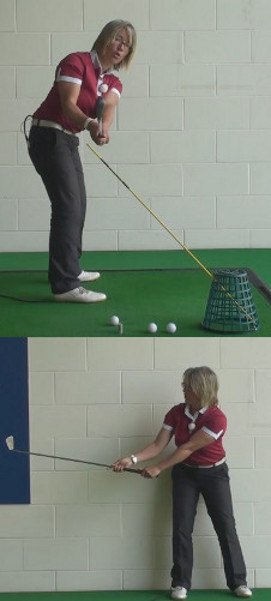
A shank is the most dreaded shot in golf, purely because the resulting ball flight is so low, flies so far to the right and with little power because of the poor connection.
However, a shank is simply produced by an incorrect movement pattern during your backswing. Once you understand this, you will be able to get your movement back under control and as a result produce a massive improvement in your golf shots.
Shanks are caused by a very flat takeaway during your backswing. This means that instead of the club head
moving away from the ball along the target line and then rising up from the target line due to the hinging of your wrists, the club head moves inside the target line and curves away from it and around your body too quickly, with your wrist hinging incorrectly to encourage this movement.
To fix this movement you need a more upright swing. Stand with your back to a wall and set up ready to hit a golf shot. Ensure that your backside is touching the wall when you are set up. Now slowly swing the club on your backswing and do not let the club head hit the wall. This will give you a more upright swing and prevent you from hitting any more shanks.

Swing Upright to Cure and Fix the Shanks
You don't have to be a great golfer to enjoy playing this wonderful game. Even if you rarely make a par and you lose golf balls on a regular basis, you can still have fun with your friends while spending time outdoors on beautiful courses. In fact, this is one of the things that makes golf so popular - it is possible for players of all skill levels to play together and still have a great game. This isn't true of most sports, and it is a big part of the reason why golf remains such a popular game for players of all ages.
While you don't need to be capable of playing great golf to enjoy this game, there is one thing that can prevent you from having fun on the course - the shanks. If you are fighting the shanks, there is almost no way that you will enjoy your time while playing golf. Simply put, the shanks can ruin the game. Hitting a shank involves the ball shooting violently off of the hosel of the club, and it is never a good feeling. The shot will head immediately to the right of your target (for a right handed golfer), and it will barely get off the ground at all. You can play some misses in golf, but you aren't going to be able to play a shank - the shot will simply be a total failure.
So, if you are fighting the shanks currently, it is crucial that you correct them as soon as possible. Not only will you need to fix the shanks if you hope to play better golf and shoot lower scores, you will need to fix them if you want to go on enjoying the game for years to come. Plenty of players have given up the game entirely because they were unable to fix the shanks, and you don't want to find yourself in that group. By putting in a little bit of focused practice time on correcting this swing issues, you should be able to take the shank out of your game once and for all.
There is no guarantee that getting rid of your slice is going to be easy, but it can be done. Most likely, there is a flaw somewhere in your swing technique that needs to be addressed. For most players, it will be just one or two small mechanical problems that are leading to this major issue. Since you only have to miss the sweet spot of the club by an inch or two in order to hit a shank, your swing isn't necessarily as far out of line as you might believe. Even seemingly small changes can have a massive impact on the quality of your game, so never assume that any technical fix is too small to make a difference. Keep an open mind, work hard on your swing, and look forward to a shank-free future.
All of the instruction contained below is based on a right handed golfer. If you happen to play left handed, please take a moment to reverse the directions as necessary.

The Mental Hurdle
Before we even get into the physical side of hitting a shank, we first need to deal with the mental half of this equation. Hitting shanks is as much mental as it is physical, so you have to be sure that your mind is in a good place before you get started looking for technical fixes. Once you have hit one or two shanks during a round, your mind starts to expect bad things to happen - and that lack of confidence is likely to lead to more shanks. This is a vicious cycle, and it is one that some players never manage to escape.
One of the keys to avoiding the shank is simply not to fear it in the first place. When you make a swing while consciously thinking about hitting a shank, you are going to naturally lead yourself in that direction. Acceleration through the ball is crucial when trying to find the center of the club face, but you aren't going to be able to accelerate with fear in the back of your mind. You have to find a way to set that fear aside and simply turn the club loose through the hitting area. Regardless of the outcome, commit yourself to hitting each shot with total confidence from the first hole to the last. For some players, this dedication to confidence will be all it takes to get rid of the shanks.
Another mental game key when it comes to the shanks is maintaining a positive attitude in the face of adversity. This is a challenge to be sure, but it can be done. After hitting a shank or two early in the round, don't allow yourself to give in to the fate of having a bad day on the course. Approach each shot as a new challenge, and look forward to hitting some great shots before the round is over. You aren't destined to shank every shot you hit just because you made that mistake on a couple of swings early in the day - even professional golfers hit bad shots, and they too are forced to focus on the positive while moving forward. Golf is a challenging game, and there will inevitably be bumps along the way. Keep your head up, embrace the challenge, and commit yourself to solving your swing issues as soon as possible.
It is important that you make sure your mind is 'in a good place' before you settle into a driving range session to work out the shank. If you find that you are too frustrated or too angry with your game to work on this problem rationally, you need to take a break and come back another day. There is no room for emotion in this process - it needs to be treated like any other problem that you have to solve in your day to day life. Trying to work out your shanks while you are emotionally upset is simply a bad idea that is likely to lead to a negative outcome. Making improvements to your golf swing is hard enough, you don't need to be trying to do it with a short temper. Once you can collect yourself and look at this problem from a rational perspective, it will become much easier to solve.

Moving in an Upright Direction
Assuming you have gotten your mind into a good place to fix the shanks, it is now time to move on to the technical side of this issue. One of the leading causes of the shanks is a golf swing that has gotten too flat - so, as a result, a common fix is to simply make the swing more upright. An upright swing is one where the hands (and the club) find a high position at the top, and the club comes into the ball on a steep angle of attack. When done correctly, an upright swing is capable of producing a beautifully controlled ball flight time after time.
Of course, it is very much possible to play good golf with a flat swing as well. You will see a number of professional golfers on Tour who use flat swings, and they don't seem to have any issue at all with the shank. So what is the difference between those professionals and the amateurs with flat swings who consistently shank the ball? The release. Pro golfers know how to release the clubhead through the hitting area in order to square up the face at impact. Amateurs, on the other hand, often struggle with this concept. If you are swinging on a flat plane and you are holding on to the release as impact approaches, you will be directing the hosel of the club straight into the back of the ball.
It is really the lack of a release that is at the core of the shank problem, which is why using an upright swing makes so much sense. There is less release required when you swing on an upright plane, because the club face will naturally square itself earlier on the way down. You still do need to release the club through the ball, but that action is easier to achieve for most players when using an upright swing compared to a flat one. Rather than forcing yourself to use an aggressive release on a flat swing, the easier fix is likely to be moving your swing plane up into a more vertical position. This upright path will enable you to make clean contact, and you probably won't even feel like a shank is possible thanks to this new swing shape.
Aside from getting rid of the shank, there are actually a number of other benefits that can be derived from using an upright swing plane. For one thing, you may find that you have an easier time hitting both a draw and fade, depending on the shot in front of you. A flat swing usually promotes a draw, which is fine, but those using a flat swing often can't switch to a fade on command. If you favor an upright plane, you might notice an improved ability to control the flight of the ball in either direction - which is a great bonus as you try to make your way around a course.
Hitting the ball higher in the air is another benefit that you may notice after you switch to a more upright swing. The downward angle of attack that you are going to be using will serve to place extra backspin on the ball, meaning the ball is going to climb higher into the air than it would when using a flatter swing. That means higher shots that stop quicker when they land - which should add up to more birdie chances. Hitting the ball high is a challenge for most amateur golfers, but it gets a bit easier when you learn how to use an upright plane.
As you can see, there are a lot of reasons to consider using an upright swing. Fixing the shank is obviously the reason that you are using to make the change, but the long list of other benefits should motivate you to make it happen as quickly and successfully as possible. Once you have transitioned your technique into a more upright shape, you will likely wonder what took you so long to make the change in the first place, as you may be playing some of the best golf of your life.

Making the Change
Moving your golf swing higher up into the air requires a few basic adjustments to be made. You don't actually need to remake your entire swing to make this change, as long as you know which parts of the swing need to be altered, and which can stay the same. Unlike other changes that you might make in your swing, the movement of your swing plane to a higher position doesn't need to take years to master - you should be able to get comfortable with it after just a few range sessions. Of course, it may take longer to see great results, but progress will be enjoyed in the relatively near future.
If you are headed to the driving range with the intention of making this type of change in your golf swing, use the following tips to get on the right track as soon as possible.
- Extension in the takeaway. The first thing you need to do is ensure that you are getting enough extension in the takeaway to move the club up into a vertical position. If you are used to making a flat swing, you probably bring the club to the inside in the takeaway - but that isn't going to work for an upright path. Keep both arms extended during the initial moments of the swing so you can create plenty of space between your body and the club.
- Active hands halfway back. Most players who make a flat swing never really engage the hands in the backswing. That is okay if you wish to stay on that flat plane, but it isn't going to work if you want to move the club up into the air. To make a vertical swing, you will need to hinge your wrists upward when the club is around halfway back. This move is really what will set the club on a vertical path, and the shaft will point up toward the sky and the rest of your backswing will follow along toward an elevated position. This change will be the most difficult to master if you are switching from a flat swing, so take your time and work on this move over and over again.
- Stable lower body. There is more movement in the lower body with a flat golf swing as compared to an upright one. Specifically, you are going to need to pay attention to the position of your right knee in the backswing. If you would like to make an upright swing, one of the best things you can do is secure the position of that knee. By holding it steady throughout the swing, the club will be forced up into the air because there won't be much space to swing in on a lower plane. It is the combination of your active hands in the backswing and your steady right knee position that will cause you to make an upright swing.
- Let it go. The backswing is where you are going to make the changes to your technique. During the downswing, your only job is to be confident and swing all the way through to a balanced finish. You don't need to intentionally do anything different in the downswing from what you were doing with your flatter swing - just accelerate the club into the ball and plan on sending it directly toward the target.
Once your takeaway and the rest of your backswing are working properly to move the club higher in the air, the rest of the job is just going to come down to repetition. It is essential that you hit as many balls on the range as possible to engrain this new style of swing. The swing is going to feel awkward at first, but it will get more and more natural with each shot that you hit. The driving range is so important to this process because it is a place where you can hit shots without worrying about the consequences of your swing changes. There is no pressure to hit good shots on the range, so experiment with various moves and feelings until you settle on a way to get the club higher that works for you.
One other point that needs to be made about the driving range is this - don't be in a rush to get back out onto the golf course with your new swing. It will be tempting to go out and test your new technique, but you want to be sure you are totally ready for that challenge before giving it a go. Complete plenty of good range sessions to build up your confidence and only book a tee time when you are sure you can trust the new swing for all 18 holes.

Danger Spots
With your work done and your swing improved, you should find that the shanks have all but disappeared from your game. It is always possible to hit the odd shank now and then - it even happens to the pros - but for the most part, this is a concern that you should be able to leave behind. However, if you would like to make sure to keep the shanks as far away from your game as possible, you should understand that there are certain shots on the course that are more likely to lead to shanks than others. The following list includes some points around the golf course where you will need to be extra careful to avoid the shank.
- A bare lie. From time to time, you will find that your ball has come to rest on bare ground which is not covered by grass (or sand). These bare lies can be dangerous when it comes to the shank, especially if the ground is dry and hard. Your club could bounce off the ground and into the back of the ball, exposing the hosel and creating the potential for a shank. When you play from a bare lie, consider choking down on your club for control and making a soft swing. The key here is to focus on clean contact rather than power, as good contact will get you back on course and allow you to avoid the dreaded shank.
- Half wedge. This just might be the most-shanked shot in golf. When you are facing a shot from a distance that only requires a soft swing with your wedge, you need to make sure to accelerate the club through the hitting area and allow the face to release nicely. If you 'hold on' to the swing because you are afraid to hit the ball too far, there is a significant risk of creating a shank.
- Delicate chip shot. In this case, you aren't even making a full swing - but you could still hit a shank. When chipping downhill to a fast green, make sure to keep your eyes down on the ball all the way through the shot. It is easy to look up early to see where the ball is going on this kind of a shot, but that head movement may bring the hosel dangerously close to the ball at impact.
Shanking the golf ball is no fun. Golf is a game, and it is supposed to be fun, but hitting shanks on a regular basis can quickly take the fun from the game. To make sure you continue to enjoy golf for many years to come, get to work right away on improving your swing technique to eliminate the shank.






